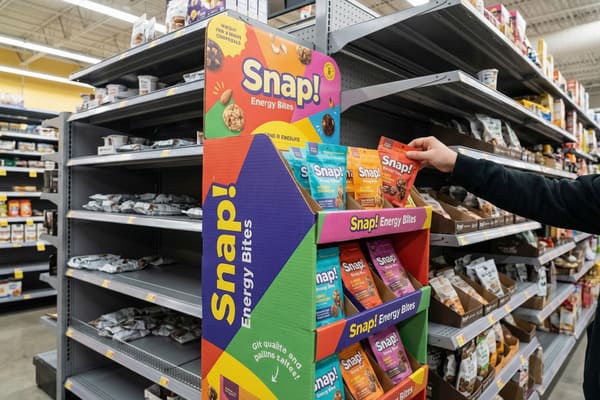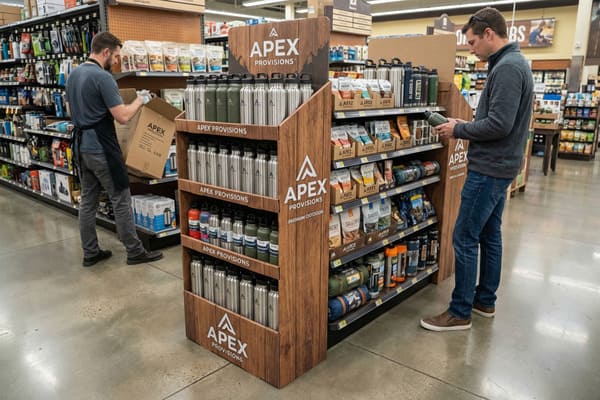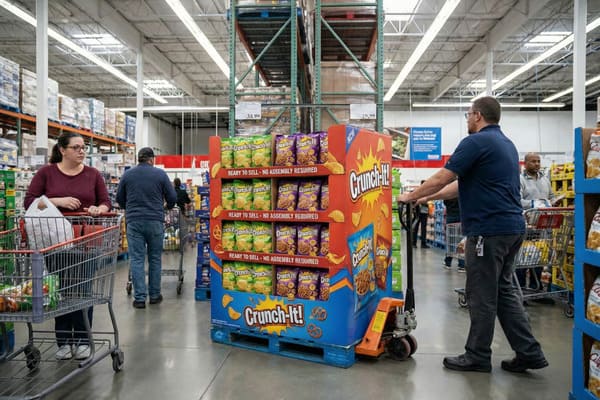Un présentoir bancal nuit aux ventes plus rapidement qu'un prix mal choisi. Si vous lancez un produit sur le marché américain, il ne vous faut pas seulement un emballage ; il vous faut un vendeur silencieux capable de résister à la brutalité d'un centre de distribution Walmart et de capter l'attention du consommateur en moins de trois secondes.
La fabrication d'un présentoir en carton suit un processus rigoureux : 1. Conception structurelle (détermination de la charge admissible et du style), 2. Prototypage (tests sur échantillon blanc), 3. Application des illustrations (ajustement des gabarits), 4. Production en série (impression, découpe, collage) et 5. Conditionnement (à plat ou en sous-emballage). Chaque étape requiert un calibrage précis des matériaux pour garantir la stabilité du présentoir.

La plupart des marques pensent que le design se résume à de jolies couleurs, mais le véritable secret réside dans la conception structurelle. Si le sens du grain est incorrect, votre présentoir s'effondre. Si les dimensions d'expédition sont erronées, vous payez pour du vide. Analysons en détail ce que sont ces présentoirs et comment les concevoir pour en tirer profit.
Qu'est-ce qu'un présentoir en carton ondulé ?
Les clients parcourent les magasins comme en transe, et les étagères classiques ne sont pour eux qu'un décor visuel. Pour les sortir de cette torpeur, il vous faut une structure qui interrompe physiquement leur regard et présente votre produit de manière isolée, à l'écart du désordre des allées.
Un présentoir en carton ondulé est un dispositif de vente temporaire et autoportant, composé de couches de carton cannelé, conçu pour mettre en valeur des produits en dehors des emplacements traditionnels des rayons. Ces présentoirs sont conçus pour stimuler les achats impulsifs en augmentant la visibilité de la marque dans les zones à fort passage, comme les têtes de gondole ou les caisses.

Anatomie structurelle des troubles visuels 1
Quand on parle de présentoirs en carton ondulé, on ne parle pas simplement de papier plié. On parle de « rupture visuelle ». Je le dis sans cesse à mes clients : si votre produit se retrouve sur une gondole métallique à côté de dix concurrents, vous êtes voué à l'échec. Un présentoir en carton ondulé isole votre produit. Mais en fabriquer un ne se résume pas à plier une boîte. Tout commence par le choix du matériau. Aux États-Unis, on utilise généralement du carton ondulé, composé d'une feuille cannelée collée entre deux feuilles de carton plat.
L'erreur la plus fréquente que je constate chez les marques est d'ignorer la « fatigue décisionnelle » du consommateur américain moyen. Elles complexifient inutilement la conception. L'objectif d'un présentoir en carton ondulé est de présenter le produit instantanément. Nous utilisons des formes spécifiques, comme des découpes courbes – que le carton permet de réaliser bien mieux et à moindre coût que le métal – pour capter l'attention. Mais voici la dure réalité : le carton craint l'humidité. Un présentoir standard en carton ondulé posé sur un sol mouillé (après le passage de l'équipe de nettoyage) se transformera en bouillie. C'est ce que nous appelons l'effet « fond détrempé ». C'est catastrophique. J'ai vu de magnifiques présentoirs à 50 $ s'effondrer parce que les cinq centimètres inférieurs avaient absorbé de l'eau.
Pour remédier à cela, nous ne nous contentons pas de fabriquer une boîte. Nous appliquons un revêtement biodégradable et hydrofuge, ou une protection anti-serpillière, sur le fond. Nous devons également calculer le sens du grain du papier. Si un concepteur place le grain horizontalement sur un mur porteur, le présentoir se déformera sous une charge de 9 kg. Mes ingénieurs alignent le grain verticalement afin d'optimiser le score du test de compression du carton (BCT). Cela nous permet d'utiliser un matériau léger qui agit comme un pilier, supportant 23 kg ou plus sans s'affaisser. Il s'agit d'utiliser les principes de la physique pour réduire les coûts des matériaux tout en améliorant les performances commerciales.
| Fonctionnalité | Étagère standard | Affichage ondulé |
|---|---|---|
| Visibilité | Bas (Perdu dans le désordre) | Vue haute (isolée et à 360°) |
| Interaction avec le client3 | Passif | Agressif (Interrompt le chemin) |
| Coût des matériaux | Haut (Métal/Fixe) | Faible (Temporaire/Recyclable) |
| Flexibilité de la forme4 | Rectangles rigides uniquement | Formes découpées illimitées |
| Risque d'humidité | Aucun | Élevé (Nécessite un revêtement) |
Je considère les cinq centimètres inférieurs de chaque présentoir comme les fondations d'une maison ; si nous n'imperméabilisons pas cette base avec un revêtement ou un vernis approprié, tout l'investissement peut être ruiné par un simple seau de serpillière.
Qu'est-ce qu'un présentoir ?
Comprendre la terminologie est essentiel pour s'approvisionner à l'étranger. Si le terme « présentoir » est générique, un « support » désigne généralement une structure spécifique conçue pour supporter un poids, qu'elle soit posée sur un comptoir ou au sol.
Un présentoir est un équipement de vente rigide, disponible sous différentes formes comme les présentoirs sur pied, les présentoirs de comptoir (PDQ) ou les présentoirs sur palette, conçu spécifiquement pour accueillir les produits. Contrairement à une simple signalétique, un présentoir combine des surfaces de communication visuelle avec des étagères robustes permettant de présenter les produits directement au consommateur.

Hiérarchie structurelle : du comptoir à la palette
La conception d'un présentoir dépend de son emplacement en magasin. On distingue trois principaux types : le présentoir de sol, le de comptoir (PDQ) et le présentoir sur palette. Chacun possède des caractéristiques physiques spécifiques.
Commençons par les présentoirs de sol. Ce sont les piliers de leur activité. Mais ils ont un défaut majeur : la « zone d'ombre ». L'éclairage des magasins provient du plafond. Si vous construisez un présentoir avec des étagères profondes et des parois pleines, l'étagère du milieu est complètement sombre. Or, les produits sombres ne se vendent pas. J'en ai fait l'amère expérience il y a des années, lorsqu'un client s'est plaint que ses stocks du bas ne se vendaient pas. Désormais, nous pratiquons des fenêtres latérales ou utilisons des doublures blanches à l'intérieur pour réfléchir la lumière. C'est un simple ajustement qui augmente la visibilité de 40 %.
Ensuite, il y a les présentoirs pour palettes Club Store 6 (pour Costco ou Sam's Club). C'est une toute autre histoire. Ce ne sont pas de simples supports ; ce sont des structures industrielles. Costco applique une règle « zéro débordement » extrêmement stricte. Si votre présentoir dépasse de 1,25 cm (0,5 pouce) la palette de 122 × 102 cm (48 × 40 pouces), le camion entier est refusé. De plus, ils exigent une capacité de charge massive, parfois supérieure à 1 134 kg (2 500 lb) de charge dynamique. Nous ne pouvons pas utiliser de carton ondulé standard de type B. Nous devons utiliser du carton ondulé de type EB ou du carton ondulé double cannelure et souvent intégrer des séparateurs en H ou des armatures internes pour éviter que les parois ne se déforment (effet de « bombement ») lorsqu'elles sont remplies de produits lourds comme des boissons.
Enfin, les présentoirs de comptoir. Le problème ici est le « point de basculement ». Si un client achète les articles situés à l'avant, le centre de gravité se déplace vers l'arrière et le présentoir se renverse. Nous devons concevoir des supports arrière plus longs ou des fonds lestés pour éviter ce désagrément.
| Type d'affichage | Exigence clé | Point de défaillance commun |
|---|---|---|
| Stand de sol | Force verticale7 | Inclinaison/Flambage sous charge |
| Affichage de palette | Conformité 48×40 | Rejet du surplomb à Washington |
| Comptoir (PDQ) | Équilibre anti-basculement8 | Bascule vers l'arrière lorsqu'il est vide |
| Bac à décharge | Force explosive | Murs bombés vers l'extérieur (poubelle « enceinte ») |
Je mesure toujours l'angle « menton relevé » sur les étagères inférieures ; en inclinant ces étagères de 15 degrés vers le haut, nous forçons le client à regarder le produit dans les yeux plutôt que ses genoux, ce qui améliore considérablement le taux de prise en main.
Qu'est-ce qu'un présentoir PLV ?
POSM signifie « supports de communication sur le lieu de vente ». Dans le secteur manufacturier, lorsqu'un acheteur demande des informations sur les supports de communication sur le lieu de vente, il fait généralement référence au calcul du retour sur investissement unitaire. Il souhaite savoir comment cette boîte en carton s'autofinance.
Un présentoir PLV est un type de support marketing spécialisé, placé précisément à l'endroit d'une transaction, et conçu pour inciter aux achats impulsifs. Ces présentoirs utilisent des visuels percutants et un positionnement stratégique pour convertir l'attention du consommateur en ventes immédiates, générant souvent un excellent retour sur investissement.

L'équation du retour sur investissement et le « lift de 3 secondes 9 »
Lorsque je fabrique un présentoir PLV, je ne vends pas du carton ; je vends un véritable coup de pouce aux ventes. Les acheteurs américains sont souvent rebutés par le prix unitaire. Ils voient un présentoir à 20 $ et le trouvent cher. Mais c’est une erreur de raisonnement. J’enseigne à mes clients le concept de « l’effet coup de pouce en 3 secondes ». Un présentoir PLV autonome augmente généralement les ventes de 400 % par rapport à un présentoir classique, car il capte l’attention du client.
Ici, l'ingénierie se concentre sur la rapidité de mise sur le marché et l'impact visuel. Pour la PLV, la qualité d'impression est primordiale. Mais attention au piège : la gestion des couleurs . Les responsables marketing valident les maquettes sur des MacBook lumineux et rétroéclairés (RVB). Or, nous imprimons à l'encre sur papier (CMJN). Résultat : des couleurs ternes et décevantes. Un rouge éclatant à l'écran paraît fade sur du carton. Pour créer un présentoir PLV qui attire vraiment le regard, j'utilise un système d'épreuvage couleur GMG. Je ne me fie pas à l'écran. J'imprime une épreuve physique sur le papier.
Un autre facteur crucial en PLV est la date limite de retrait. Ces présentoirs sont temporaires. Si un présentoir d'Halloween est encore en place en novembre, cela nuit à l'image de marque. Nous imprimons d'ailleurs un code au dos indiquant « À retirer avant le : [Date] » pour faciliter la mise en œuvre en magasin. Et pour l'agencement ? Nous nous concentrons sur la zone d'attraction. La consommatrice américaine moyenne mesure 1,63 m. Nous concevons l'étagère du produit phare à une hauteur précise de 127 à 137 cm du sol. C'est la hauteur d'achat optimale. Si vous placez votre article à forte marge sur l'étagère du bas, vous gaspillez de l'argent.
| Métrique | Étagère domestique (standard) | Présentoir PLV |
|---|---|---|
| Taux de vente11 | 1x (Ligne de base) | 4x – 5x |
| Rappel de la marque12 | Faible | Haut |
| Compétition visuelle | Haut (Voisins) | Zéro (Autonome) |
| Temps de configuration | N / A | < 5 minutes (Objectif) |
Je conseille à mes clients d'ignorer le coût initial de l'affichage et de se concentrer sur la marge ; si la vente de 50 unités supplémentaires couvre le coût de la structure dès le deuxième jour, les 28 jours restants de la campagne représentent un bénéfice pur et simple.
Quel est le code SH pour les présentoirs ?
Si vous importez des écrans de Chine vers les États-Unis, le code SH (Système harmonisé) détermine le taux de droit de douane applicable. Une erreur de saisie pourrait vous valoir une facture de droits de douane imprévue de 25 % ou un contrôle approfondi de votre conteneur à Long Beach.
Le code SH principal pour les présentoirs en carton ondulé est le 4819.10, qui couvre les cartons, boîtes et caisses en papier ou carton ondulé. Cependant, selon leur contenu et leur fonction, certains présentoirs peuvent être classés sous le code 4823.90 ou strictement comme imprimés (4911.10), ce qui influe sur le taux de droit de douane.

Comprendre les douanes et les tarifs douaniers américains
Depuis le début de la guerre commerciale, l'importation de présentoirs en carton est devenue un véritable casse-tête. Le code standard est souvent 4819.10, mais c'est là que les choses se compliquent. Si le présentoir est importé vide , il est considéré comme un emballage. S'il est importé pré-rempli de produit (conditionnement à façon), la classification change complètement : généralement, le présentoir devient un emballage secondaire pour le produit lui-même, et les droits de douane sont calculés sur le code du produit, et non sur celui du carton.
J'aide mes clients à optimiser leurs factures. Par exemple, faire la distinction entre « supports imprimés » (publicité) et « emballages » peut parfois modifier le montant des droits de douane. Mais il faut être honnête. Les douanes américaines ne plaisantent pas. J'ai vu des conteneurs bloqués pendant trois semaines parce qu'un fournisseur avait tenté de tricher avec les codes.
Un autre cauchemar est la déclaration ISF 10+2 (formulaire 13 ). Celle-ci doit être déposée 24 heures avant le départ du navire de Chine. Nombre d'usines l'oublient. Tout retard entraîne une amende de 5 000 $ pour l'importateur (vous), ce qui anéantit instantanément vos bénéfices. Mon équipe dispose d'un coordinateur logistique dédié qui transmet ces données 72 heures à l'avance. Il faut également se méfier du piège du « Poids volumétrique 14 ). Le transport de marchandises « à vide » réduit considérablement les marges. J'optimise les dimensions des cartons pour qu'ils s'adaptent parfaitement au conteneur 40HQ. Parfois, remplacer une étiquette d'en-tête simple par une étiquette double permet de gagner 20 % d'espace dans le conteneur. Cela représente des milliers de dollars d'économies sur le fret, simplement en ajustant les lignes de pliage.
| Code HS | Description | Cas d'utilisation typique |
|---|---|---|
| 4819.10 | Boîtes/caisses en carton ondulé15 | Écrans standard |
| 4823.90 | Autres papiers/carton | Structures spécialisées |
| 4911.10 | Matériel publicitaire commercial16 | Signalétique/En-têtes uniquement |
| 9403.89 | Meubles en autres matériaux | Installations permanentes/semi-permanentes |
Je ne me contente pas d'expédier des cartons ; je fournis la documentation conforme et des conseils spécifiques sur le code SH afin de garantir que votre conteneur passe la douane américaine sans déclencher inutilement les droits de douane punitifs de la section 301.
Comment assembler un présentoir ?
Le plus beau présentoir du monde ne vaut rien si l'employé du magasin le jette à la poubelle parce qu'il est incapable de le monter. L'assemblage représente le principal point de défaillance de la chaîne de distribution.
Pour assembler efficacement un présentoir : 1. Dépliez le corps principal (tour), 2. Verrouillez les languettes de support internes ou le fond automatique, 3. Insérez les étagères en vous assurant que les languettes s'enclenchent correctement, 4. Fixez la carte d'en-tête sur le dessus, et 5. Placez les produits selon le planogramme.

Éliminer l'échec de « l'exécution en magasin »
Soyons réalistes : personne ne lit les notices. Le vendeur chez Target ou Walmart est débordé, sous-payé et, de toute façon, l’anglais n’est probablement pas sa langue maternelle. Si je lui envoie un manuel trop dense, il l’ignorera. Résultat ? Un présentoir bancal qui nuit à votre image de marque, ou pire, le scénario catastrophe du « sac rouge » où il perd une attache en plastique essentielle et jette tout l’appareil à la poubelle.
Pour remédier à cela, j'ai mis au point la « Stratégie du sac rouge n° 17 ». Nous collons un petit sac rouge contenant 5 % de pièces de rechange (clips supplémentaires) directement sur la notice. Cela ne coûte presque rien, mais permet de réaliser toute l'installation. Nous avons également constaté que les notices papier sont obsolètes. Désormais, nous imprimons un grand QR code sur l' extérieur du carton principal. Le personnel le scanne et une vidéo de 30 secondes s'affiche, montrant précisément comment ouvrir le présentoir. Plus besoin de lire.
Nous concevons également des présentoirs « Zéro frustration » . Pour les présentoirs sur palettes, nous évitons strictement les pliages complexes de type origami. Nous utilisons des plateaux modulaires pré-encollés. Le personnel du magasin n'a plus qu'à les empiler. Un casse-tête de 20 minutes se transforme ainsi en un empilage de 5 minutes. Nous utilisons également des languettes d'empilage emboîtables qui s'emboîtent comme des Legos. Ainsi, même si le camion heurte un nid-de-poule, les plateaux ne glissent pas. Si un présentoir prend plus de 5 minutes à monter, il ne sera pas monté. Point final.
| Fonctionnalité | Méthode traditionnelle (risque d'échec) | Nouvelle voie (Succès) |
|---|---|---|
| Instructions | Manuel en texte dense | Code QR vidéo19 |
| Matériel | Compte exact (approximatif) | Sac rouge (Pièces détachées) |
| Structure | Pliage complexe | Pré-collé / Pop-up20 |
| Temps d'assemblage | Plus de 15 minutes | < 5 minutes |
Je suis convaincu que si votre processus d'assemblage repose sur la lecture d'un manuel par un adolescent, vous avez déjà échoué ; c'est pourquoi j'ai placé le lien vidéo directement sur la boîte pour garantir le respect des consignes.
Conclusion
Concevoir un présentoir en carton, ce n'est pas simplement imprimer un logo sur une boîte ; c'est créer un outil indispensable pour se démarquer dans le monde impitoyable du commerce de détail. Du revêtement anti-débordement aux angles d'inclinaison optimisés pour les étagères, chaque pli a un impact financier. Il vous faut un partenaire qui comprenne la différence entre une belle présentation et une machine à générer des profits.
Si vous êtes prêt à voir à quoi ressemble votre produit sur une structure réellement fonctionnelle, je peux fournir à votre équipe un rendu 3D structurel gratuit sous 24 heures, ou nous pouvons découper un échantillon physique blanc pour prouver la stabilité avant que vous ne dépensiez le moindre sou en outillage.
Comprendre la disruption visuelle peut améliorer vos stratégies marketing et permettre à votre produit de se démarquer dans des environnements concurrentiels. ↩
L'étude du sens du grain permettra de mieux comprendre comment optimiser la conception des écrans pour une durabilité et des performances accrues. ↩
Comprendre les interactions agressives des consommateurs peut améliorer votre stratégie de vente au détail, en générant plus de ventes et un engagement client accru. ↩
L'exploration de la flexibilité des formes peut révéler des solutions d'affichage innovantes qui attirent davantage de clients et améliorent la visibilité des produits. ↩
Explorez ce lien pour découvrir des stratégies de conception efficaces pour les présentoirs de comptoir qui améliorent la visibilité et la stabilité des produits. ↩
Découvrez les directives de conception essentielles pour les présentoirs sur palettes des Club Stores afin de garantir leur conformité et d'optimiser leur capacité de chargement. ↩
Comprendre la résistance verticale est essentiel pour garantir que les écrans puissent supporter la charge prévue sans défaillance. ↩
L'étude du système d'équilibre anti-basculement permet de concevoir des présentoirs plus sûrs qui empêchent le basculement, notamment lorsqu'ils sont vides. ↩
Comprendre le phénomène des 3 secondes d'ascension peut considérablement améliorer votre stratégie marketing et vos performances commerciales. ↩
L’exploration de la gestion des couleurs vous aidera à éviter les pièges courants de la conception d’imprimés et à garantir des couleurs éclatantes et précises. ↩
Comprendre les taux de conversion moyens peut vous aider à évaluer l'efficacité de vos stratégies d'affichage. ↩
Explorer la relation entre la notoriété de la marque et les achats peut améliorer vos efforts marketing. ↩
Comprendre la déclaration ISF 10+2 est essentiel pour éviter de lourdes amendes et garantir un dédouanement sans encombre. ↩
Découvrez comment le poids volumétrique influe sur les frais d'expédition et apprenez des stratégies pour optimiser vos coûts d'expédition. ↩
Explorez ce lien pour comprendre comment les boîtes en carton ondulé améliorent la protection des produits et réduisent les coûts d'expédition. ↩
Découvrez comment les supports publicitaires commerciaux peuvent accroître la visibilité et les ventes de votre entreprise. ↩
Explorez ce lien pour comprendre comment la stratégie du sac rouge peut améliorer l'efficacité de l'installation et prévenir les erreurs coûteuses. ↩
Découvrez comment les principes de conception « zéro frustration » peuvent simplifier les processus d'assemblage et réduire la frustration du personnel en magasin. ↩
Découvrez comment les codes QR vidéo peuvent améliorer l'expérience utilisateur et simplifier les instructions, rendant ainsi l'assemblage plus rapide et plus facile. ↩
Découvrez les avantages des conceptions pré-collées et pop-up pour réduire le temps et la complexité d'assemblage. ↩





